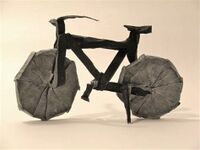Stationary bicycle
The stationary bicycle is the bicycle's legless cousin. It is popular with introverts, as it lets them 'go for a ride' without the risk of greeting their neighbours. It is also called the 'exercise bike' and is a regular household accessory for those wishing to lose weight or build up chunky muscled legs. They too can get hot and sweaty in the comfort of their own home, rather than at a workout center where their poor progress toward their fitness goal might attract ridicule.
Despite being simple machines on paper, many models cost a lot of folding paper, for no reason other than to expand the wallets of the C.E.O.'s who produce them. Models with various 'Go faster, you bastard' speed stripes and zigzag designs especially seem faster than competing brands, for those with excess cash. A few models accommodate a playing card, which generates motorcycle-like noise suggesting breakneck speed.
History[edit]
The earliest documented appearance of the stationary bicycle was in the middle 1700's, when two con artists attempted to sell the contraption at a market in Normandy. The vendors claimed it was ideal for travel on France's rivers, and that this is why it lacked wheels. Since this wasn't the Middle Ages and people were no longer so gullible, the public disregarded the machinery as nothing more than a joke. It wasn't until the French Revolution that the public got gullible again, and the stationary bicycle was replaced by the guillotine.
Alternative uses[edit]
Just like the dusty piano in that lonely corner of a basement or that giant fan lying around, the stationary bike serves as an ideal eyesore and discussion piece. Guests may relate to it with, "Why did you buy that darned thing if you never use it?" or, "Are you planning to sell it soon? I've got a friend who would love to take that off your hands!" (The friend would never actually do so.)
Variants of the bike can produce electricity. However, these are only really purchased by the following:
- Doomsday aficionados anxious to cook their huge stores of canned food the day after the big bang, as the cans are all past the expiration dates
- Forest-dwellers with frequent power outages
- Climate activists who want to avoid pollution of the air and water (beyond the massive pollution needed to manufacture the bicycle) and
- Homeowners skimping on electric bills.
Stationary bicycles are also used by recovering sex addicts, as the machines are ideal for destroying one's sexual appetite.
Recent developments[edit]
Across the water in Boston, where they remain plenty gullible, 2022 was the year of frequent outages on the metropolitan trolley, including a month-long closure of one of the lines. Crews responded by painting new bicycle lanes. This necessarily led to fewer car lanes, producing so many traffic jams that the stationary bicycle was once again the vehicle of choice to keep pace with other traffic on the road.
Other similar items[edit]
Bicycles are a difficult challenge for students of origami, the Japanese art of paper-folding. However, those who pursue the art into their sophomore year may get paper to fold in the shape of tyres, handle bars, and panniers. Sticklers for precise spelling call this a stationery bicycle.

